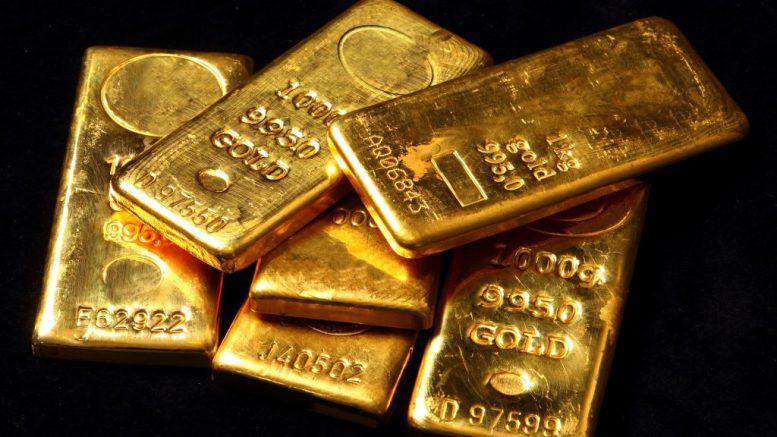The outlook for gold remains strong this year based on continued central bank buying; the metal’s role as a hedge against inflation and higher-risk investment in artificial intelligence; and demand from Chinese investors, BMO Capital Markets says.
The main headwind the bank sees for gold is the possibility of lower geo-political risk, which could dampen its allure as a safe haven. But even with the recent collapse of the Assad regime in Syria and the prospect of a deal to end the war in Ukraine, a power vacuum in the Middle East could sustain gold’s role as a safe harbor.
The incoming Trump administration’s policies of heightened tariffs and more government spending are inherently inflationary and could drive more investors into gold as an inflation hedge, BMO forecasts in its latest report: “Prolonging Gold’s Golden Era: Five Key Themes for 2025”.
Dedollarization
BMO expects central banks will continue to add to their gold reserves this year, maintaining last year’s trend towards dedollarization.
Gold holdings as a percentage of total reserves reached a record 18% in the third quarter of 2024, according to the World Gold Council, and quarterly central bank gold additions since the fourth quarter of 2022 have averaged above 1,000 tonnes on a rolling four-quarter basis, BMO noted.
“The threat of inflation and dollar index trading significantly above its historic average is enough to make central banks nervous about being overweight in treasuries at the best of times; however when combined with the potential threat of default represented by a persistent U.S. deficit in a high rate environment, we can reasonably expect dedollarization of central bank holdings to continue into 2025.”
Hedge vs AI bottlenecks
Information technology stocks, which make up about a third of the S&P 500, are expensive with an average price to earnings (P/E) ratio of more than 35. (The average S&P 500 P/E ratio currently sits at over 25, the highest in more than two decades.)
The effect of this rally can be seen in currency markets as well, BMO said, based on data from the U.S. Department of Treasury. It suggests that net foreign acquisitions of U.S. securities and banking flows has averaged US$93 billion per month since the beginning of 2022. The investments from abroad hit a record high of US$398 billion in September, spurring the U.S. dollar index to historically high levels.
But there are a number of pitfalls that could slow AI’s rollout compared to expectations, BMO stated.
The first is that there just won’t be enough power supply to support the datacenters that will be required, especially as power consumption for AI increases massively as its tasks get more complex.
Some companies are pursuing re-opening nuclear plants while others are investing in technologies such as small modular reactors. They typically have a power capacity of up to 300 megawatts of electricity per unit.
While some of these efforts will be successful, it’s likely that many will have to scale back their plans for datacentre capacity.
This could have two consequences—both of which are positive for gold.
“The first would be that investors may begin to price in an even wider U.S. deficit as U.S. GDP growth expectations are reduced, potentially pushing down bond yields as investors seek a safer haven for their capital,” BMO said. “The second effect would be a wider sell-off in U.S. equities, especially tech stocks, which has the potential to reverse record U.S. capital inflows and weaken the dollar, especially if yields are low.”
Chinese demand
In December, Beijing proposed weakening the renminbi by as much as 15% to counteract U.S. tariffs, and the currency has already depreciated since September, which will likely increase the allure of gold for investors in China.
China’s flagging property market and a slowdown in Chinese equities will also have a positive effect on gold, BMO forecasts.
While the key drivers of gold demand this year — inflation hedging and dedollarization —will sustain the metal’s strong prospects, a slight headwind could be that there will be less demand for gold as a crisis hedge, BMO warned.
“While 2025 will have no shortage of geopolitical intrigue pertaining to trade wars and possibly currency wars, the intensity of actual wars might be showing signs of diminishing.”
BMO notes that the fall of Assad’s government in Syria is a major blow to Iranian influence and could result in fewer tensions between Israel and Lebanon. Meanwhile, a ceasefire in the Ukraine is high on Trump’s to-do list, and the Israel-Gaza conflict could be resolved, although Trump’s pro-Israel stance could prolong it.
At the same time, however, unexpected impacts could emerge from a power vacuum in the Middle East created by the weaker influence of Iran and Syria, the bank said.
Equities to brighten
While higher gold prices last year failed to translate into a good year for gold equities (the GDX and GDXJ indexes rose just 10% and 15%, respectively, versus a 26% jump in the gold price), BMO believes that cost management and capital allocation will be a key focus for gold companies this year. Thatcould ultimately generate stronger free cash flow.
“We expect management of gold companies to maintain their focus on growth, deleveraging, and capital returns,” the bank said.
“There will be competition for capital given the ex-growth nature of the sector, but we believe the focus will generally remain on asset recapitalization, portfolio rationalization driven by M&A mandates, exploration (greenfield and brownfield), and lower capital intensity projects rather than large-scale, capital-intensive greenfield opportunities.”


Be the first to comment on "‘Sustained strength’ for gold in 2025: BMO"